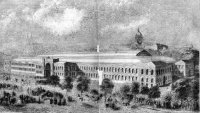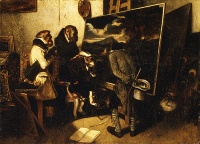Exposition Universelle (1855)
From The Art and Popular Culture Encyclopedia
| Revision as of 16:33, 23 January 2013 Jahsonic (Talk | contribs) ← Previous diff |
Current revision Jahsonic (Talk | contribs) |
||
| Line 1: | Line 1: | ||
| [[Image:Palais de l'Industrie, construit pour la première exposition universelle.jpg|thumb|right|200px|Palais de l'Industrie at the ''[[Exposition Universelle (1855)|Exposition Universelle]] ([[1855]])]] | [[Image:Palais de l'Industrie, construit pour la première exposition universelle.jpg|thumb|right|200px|Palais de l'Industrie at the ''[[Exposition Universelle (1855)|Exposition Universelle]] ([[1855]])]] | ||
| + | [[Image:The Experts, 1837 by Alexandre-Gabriel Decamps.jpg |thumb|200px|''[[The Experts]]'' ([[1837]]) by [[Alexandre-Gabriel Decamps]]]] | ||
| {{Template}} | {{Template}} | ||
| Line 12: | Line 13: | ||
| Today the exposition's sole physical remnant is the théâtre du Rond-point des Champs-Élysées designed by architect [[Gabriel Davioud]], which originally housed the Panorama National. | Today the exposition's sole physical remnant is the théâtre du Rond-point des Champs-Élysées designed by architect [[Gabriel Davioud]], which originally housed the Panorama National. | ||
| - | === Le Palais des Beaux-Arts === | ||
| - | |||
| - | Si [[Londres]] a devancé [[Paris]] pour la tenue de la première [[Exposition universelle]], la [[France]] est en 1855 la première nation à offrir une grande exposition internationale d'[[art contemporain]], [[peinture]], [[gravure]], [[lithographie]], [[sculpture]], [[médailles]] et [[architecture]]. | ||
| - | |||
| - | Sur les plans de l'architecte [[Hector Lefuel]] on édifie [[avenue Montaigne]] un Palais des Beaux-Arts. La façade en forme de fer à cheval est de style Renaissance. Là, s'exposent 28 nations, 4979 œuvres et 2176 artistes, dont 1072 artistes français. Ces œuvres sont admirées par un million de visiteurs. | ||
| - | |||
| - | Citons [[Frédéric Auguste Bartholdi]] avec sa statue du général Rapp et [[Jean-Léon Gérôme]] avec sa peinture ''[[Le siècle d’Auguste et la naissance de Jésus-Christ]]''. | ||
| - | |||
| - | [[Charles Baudelaire]], critique d'art reconnu dans le milieu des [[Salon de peinture|Salons]], écrit trois articles sur l'Exposition. Ces articles sont réunis dans l'ouvrage posthume ''[[Curiosités esthétiques]]''. | ||
| - | |||
| - | En marge de l'Exposition, [[Gustave Courbet]], dont onze œuvres sont exposées officiellement, est furieux de ne pas voir choisie sa composition ''[[L'Atelier du peintre]]''. Il fait bâtir à côté du Palais des Beaux-Arts un pavillon de bois et de briques, le ''[[Pavillon du réalisme]]'' où il expose ''[[L'Atelier du peintre]]'' et une quarantaine d'autres œuvres. | ||
| - | |||
| ==See also== | ==See also== | ||
| *[[Paris Salon of 1855]] | *[[Paris Salon of 1855]] | ||
Current revision

|
Related e |
|
Featured: |
The Exposition Universelle of 1855 was an International Exhibition held on the Champ de Mars in Paris from May 15 to November 15, 1855. Its full official title was the Exposition Universelle des produits de l'Agriculture, de l'Industrie et des Beaux-Arts de Paris 1855.
The exposition was a major event in France, then newly under the reign of Emperor Napoleon III. It followed London's Great Exhibition of 1851 and attempted to surpass that fair's The Crystal Palace with its own Palais d'Industrie. The industrial and art exhibits shown on this occasion were considered superior to those of all previous exhibitions.
According to its official report, 5,162,330 visitors attended the exposition, of which about 4.2 million entered the industrial exposition, and 0.9 million entered the Beaux Arts exposition. Expenses amounted to upward of $5,000,000, while receipts were scarcely one-tenth of that amount. The exposition covered 16 hectares (39 acres) with 34 countries participating.
For the exposition, Napoleon III requested a classification system for France's best Bordeaux wines which were to be on display for visitors from around the world. Brokers from the wine industry ranked the wines according to a château's reputation and trading price, which at that time was directly related to quality. The result was the important Bordeaux Wine Official Classification of 1855.
Today the exposition's sole physical remnant is the théâtre du Rond-point des Champs-Élysées designed by architect Gabriel Davioud, which originally housed the Panorama National.
See also
- Paris Salon of 1855
- Exposition universelle, 1855, Beaux-arts , a text by Charles Baudelaire
- The Pavilion of Realism


